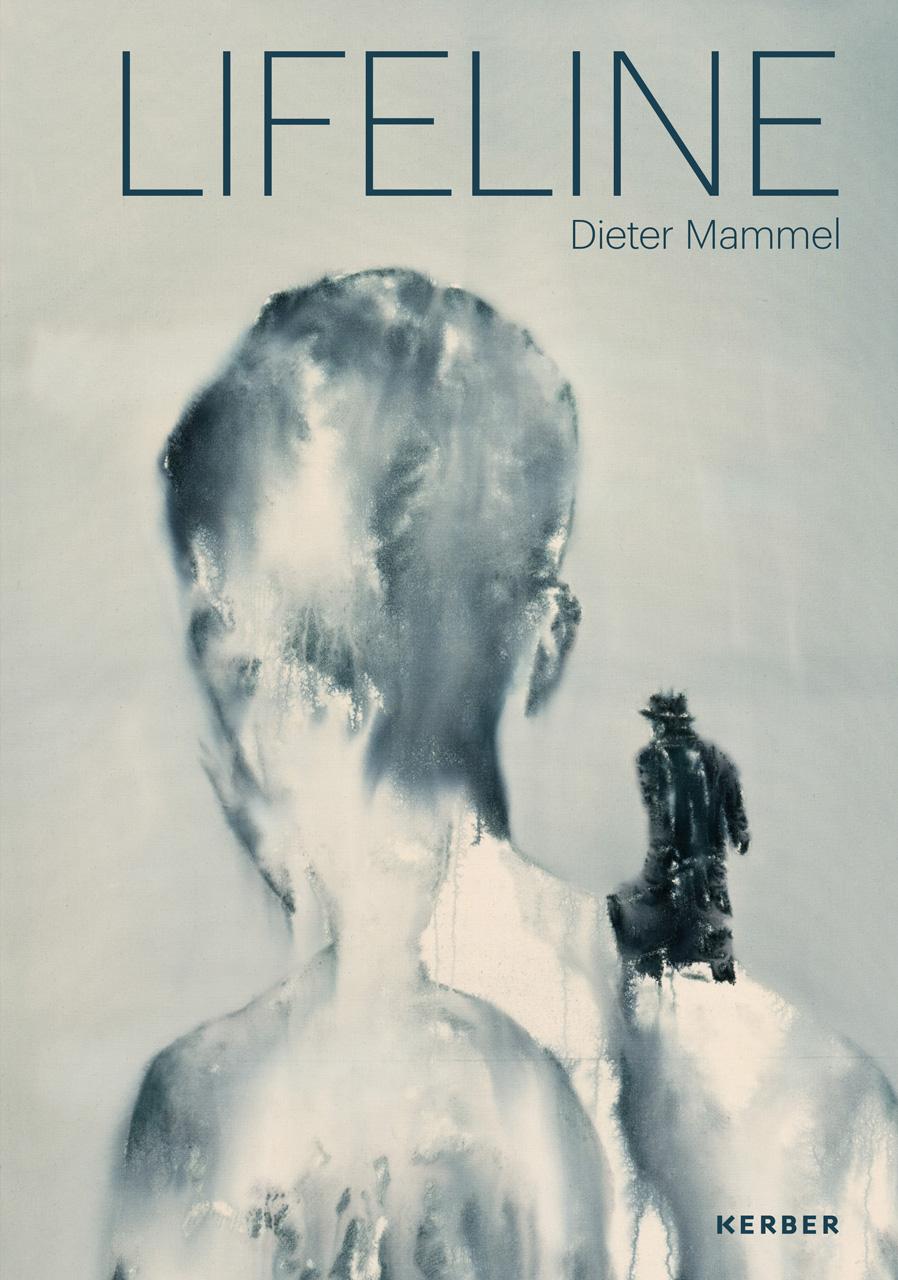
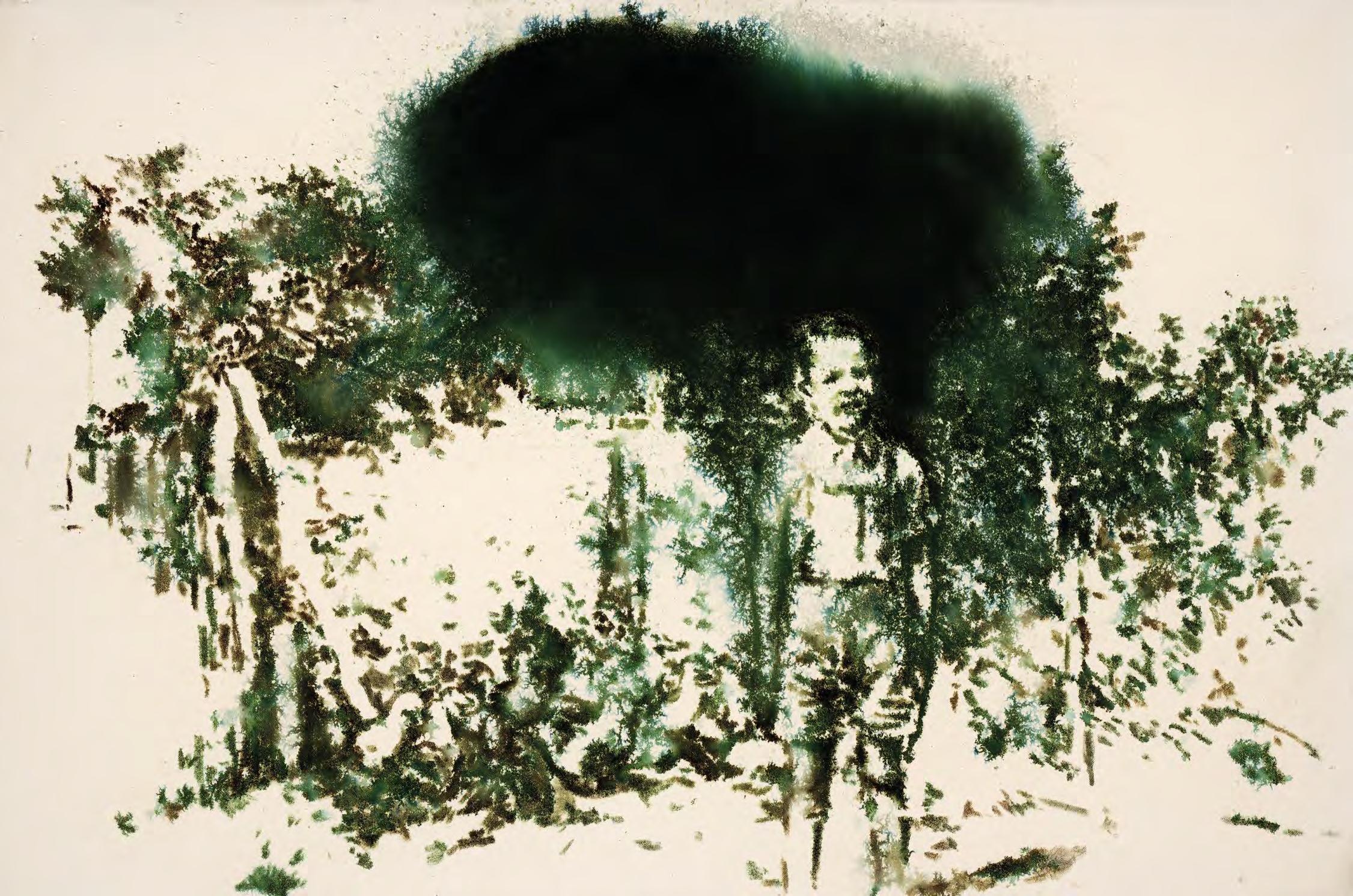

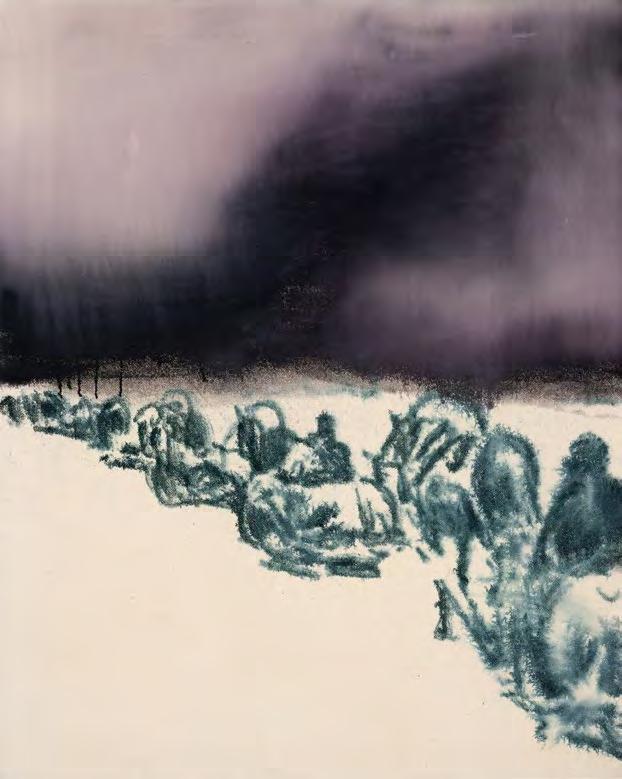
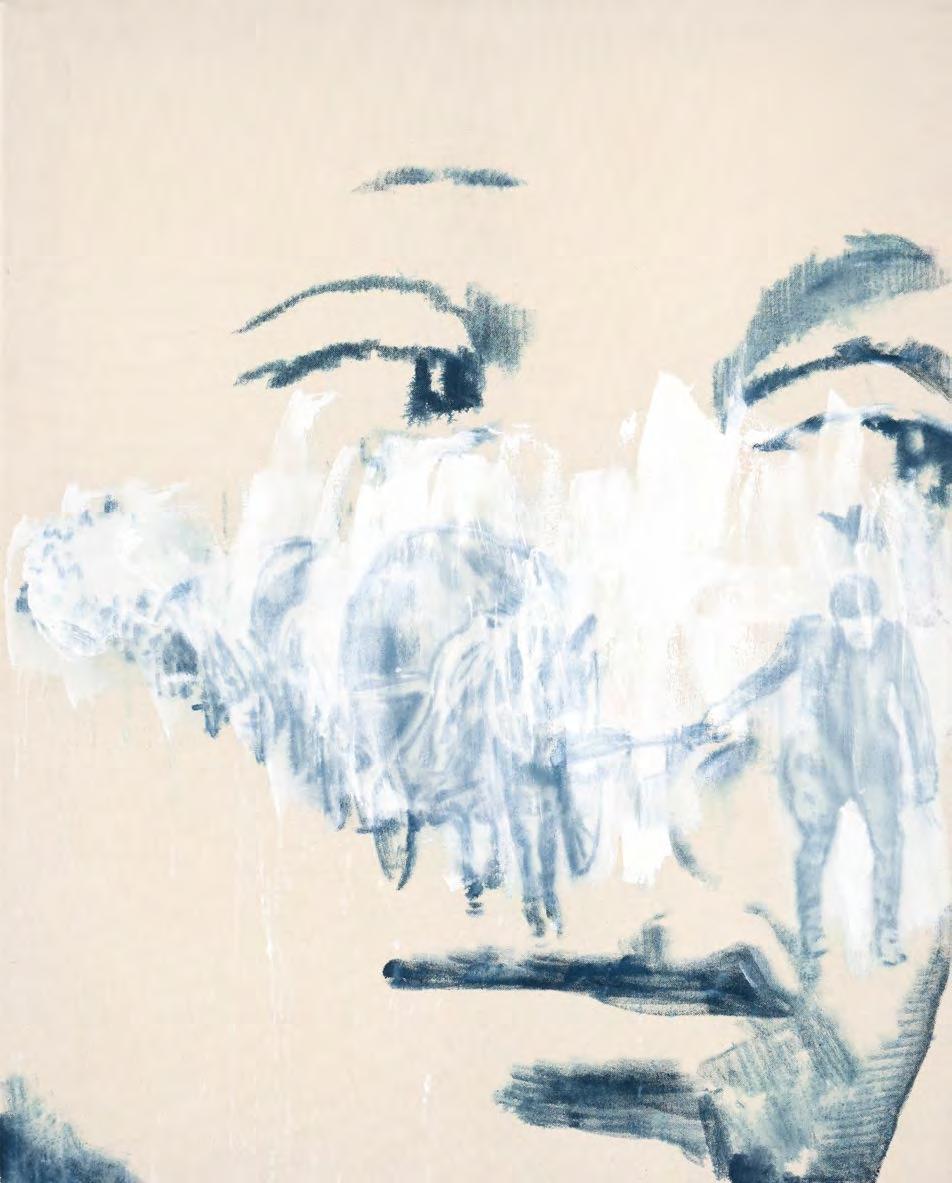
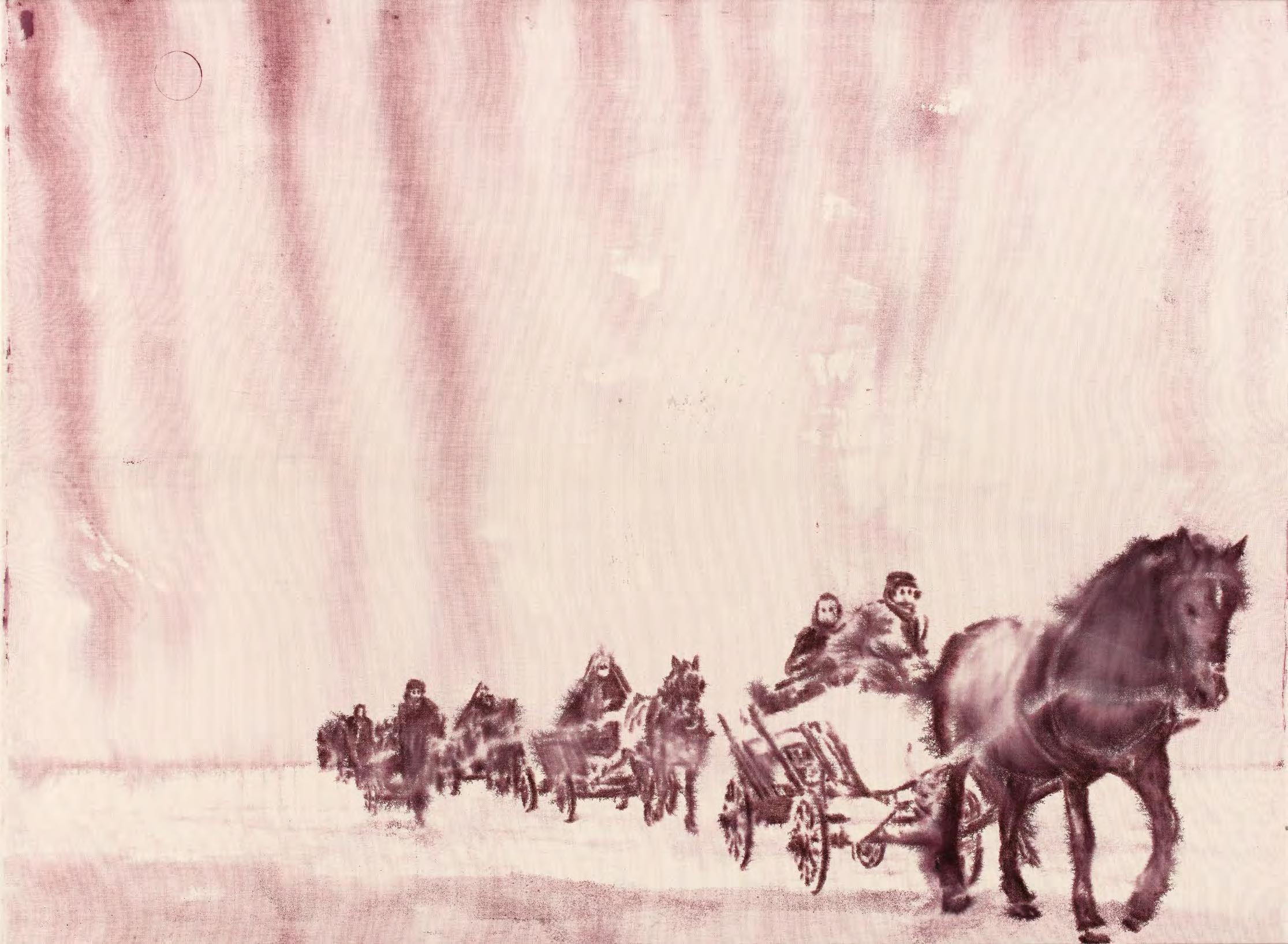



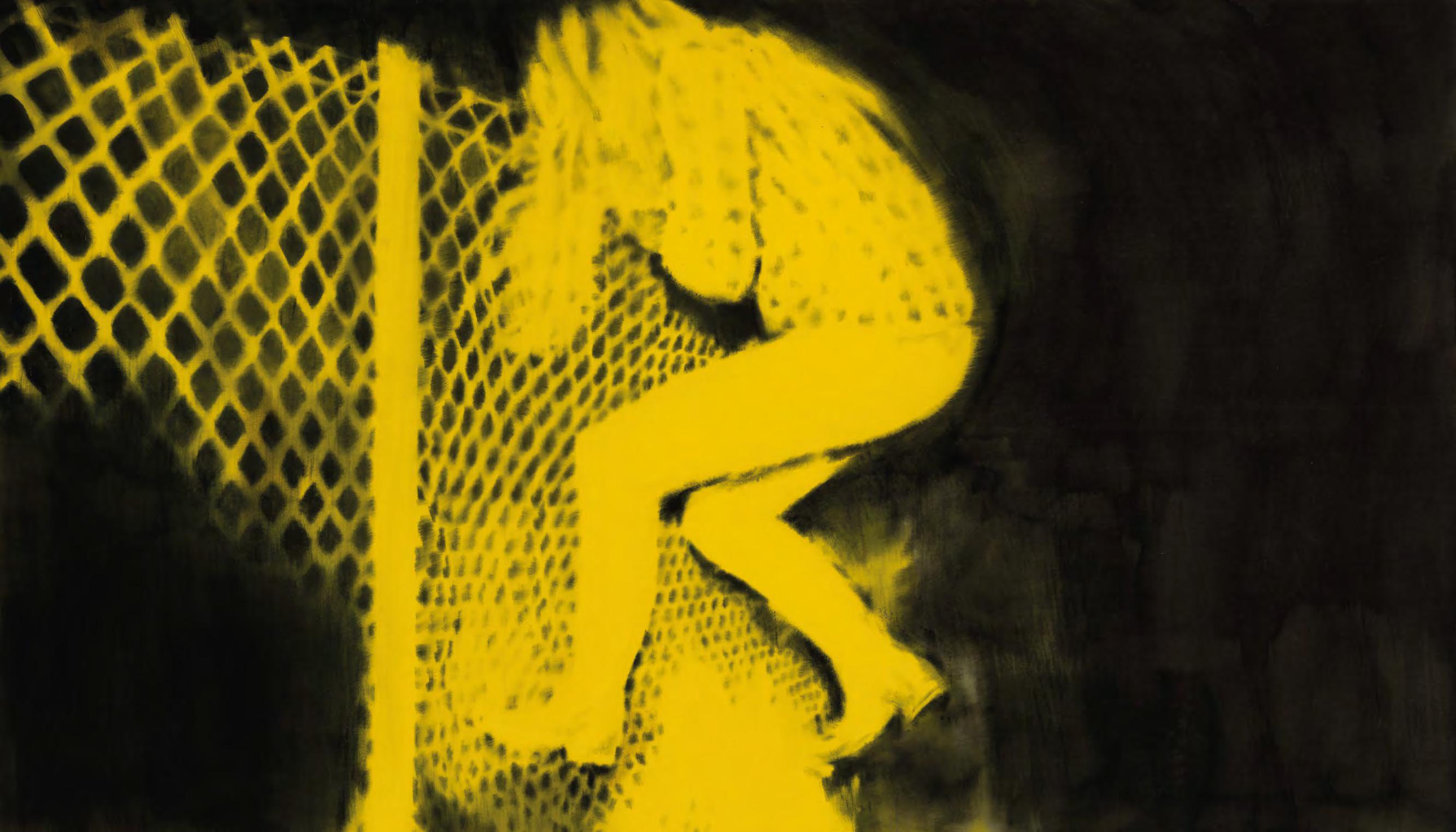













Krieg und die damit einhergehende Gewalt zählen zu den Hauptauslösern für die Entscheidung von Menschen, ihr Land zu verlassen.
Auch für Dieter Mammels Familie sind die Flucht und der Verlust der ehemaligen Heimat ein bis in die Gegenwart dauerndes, zentrales und traumatisches Moment.
Bevor seine Großmutter Elisabeth Hild zusammen mit ihren kleinen Töchtern Waltraud und Ingeborg Kač arevo/ Franzfeld, Serbien verlässt, versorgt sie in „Letzte Fütterung“ die Hühner noch ein Mal. Gedankenverloren wirft sie ihnen Körner aus der Schürze zu, während hinter ihr Rauchschwaden den Himmel verdunkeln. „In Flammen“ gehen die Häuser in der Nachbarschaft auf, doch sie und die Kinder können mit dem letzten Militär flugzeug nach Österreich fliehen. Von ihrem Mann fehlt jede Spur, er wurde in die deutsche Armee eingezogen. „In Flammen“ steht zu dem Zeitpunkt auch das geliebte Elternhaus in Jamu Mare/Großscham, Rumänien.
Dieter Mammel setzt sich in seinen Werken mehrfach und über Jahre hinweg, mit den Folgen und dem Ausmaß kriegerischer Zerstörung auseinander. Er verbindet dabei eigene Familiengeschichte mit kollektiven Fluchterinnerungen. Einige der Ausstellungswerke zeigen lange Trecks in Planwagen, die über Wochen hinweg versuchen, den kriegerischen Auseinandersetzungen deutscher und russischer Truppen zu entgehen. „Hinterm Horizont“, „Weg“, „Banat 1“ und „Banat 2“ oder „Homeless“ greifen diese
kollektiven Erzählungen auf. Die Verzweiflung und Hilflosigkeit der Flüchtenden thematisiert der Künstler in „Das verlorene Kind“ und „Die Verletzung“.
Doch auch die, die überleben, denen die Flucht in ein Land gelingt, das sie aufnimmt, bleiben zeitlebens in den Erinnerungen gefangen. Bei ihnen hat sich die „Flucht im Kopf“ festgesetzt, ist zum Bestandteil des generationenübergreifenden Narrativs geworden. Die Lebenslinien der einzelnen Menschen werden durch den Krieg bestimmt. Eine Wahl haben sie nicht, sie sind Spielbälle der Weltlage.
War and the violence it unleashes are the main reasons for people deciding to leave their homeland.
For Dieter Mammel’s family, too, escape and the loss of their onetime home is a central issue that is both permanent and traumatic.
Before his grandmother Elisabeth Hild leaves Kač arevo/ Franzfeld, Serbia, together with her small daughters, Waltraud and Ingeborg, she feeds the hens one last time ”Letzte Fütterung“ (Last Feeding). Lost in thought, she throws them the grains from her apron, while behind her the sky darkens with clouds of smoke. The neighboring houses go up ”In Flammen“ (In Flames), but she and the children manage to flee on the last military plane to Austria. There’s no trace of her husband – he had been drafted into the German army. Their beloved family home was at that point also “In Flames” in Jamu Mare/Großscham Romania.
Repeatedly and over the course of years, Dieter Mammel has dealt in his work with the consequences and the enormity of the destruction of war. He links his own family history with the collective memory of flight. Some of the works in the exhibit show long treks in covered wagons that for weeks at a time attempt to escape the f ighting between the German and Russian troops. ”Hinterm Horizont“ (Behind the Horizon), ”Weg“ (A Way), ”Banat 1” and ”Banat 2”, or ”Homeless“ take up this collec -
tive story. The artist has portrayed the helplessness and the despair of the refugees in ”Das verlorene Kind“ (The Lost Child), and ”Die Verletzung“ (The Wound).
But even those who survive, who manage to flee to a country that takes them on – even they stay captive in their memories for the rest of their lives. For them, the ”Flucht im Kopf“ (Escape in the Head) has taken hold and will become an essential part of a narrative that will be passed on to coming generations. The trajectories of these people’s lives are then determined by the war. They have no choice, they are no more than pawns in this merciless struggle for power.


You can see them – the conflicts, the rupture lines, the radical upheavals that have split the world apart, that are splitting it apart, have done so yesterday and are still doing so today. This painter is their witness.
Christoph Tannert
Notes:
(1) Dieter Mammel, email to the author, 2.11.23
(2) Dieter Mammel, studio interview with the author, Berlin, 27.10.23.
What does not immediately meet the eye is that Dieter Mammel’s art is to a large degree driven by watchful reminiscence and the silent pauses of a deep breath. This stillness and watching is an ofering of something precious, meaningful, that kindles the artistic process, again and again. It is the freedom of a humanity, carried out, indeed, with its own pathos, that allows a backwards look at his family, his origins. Just as he slowly sets into motion the flow of colors – all the time amazed at the waywardness of the materials – so in the same way, he sets out onto a path of memory, in a creative conversation with his interior pictorial world, probing for the truth. Attentively, and as an explorer poet, without any complex explanatory dramaturgy, he brings f igures to life, sometimes even their shadows, contemplates violence, contemplates conscience. Often, adding to the already high intensity, the artist turns over his canvas – which is lying flat on the floor – f irst working on the front, then later on the back side. Mammel integrates the shapes created by the bleeding-through into the composition of the opposite side, as for example in ”Trauma" (Grandfather in Bed), with the picture ”Traum“ (Dream) on the reverse, both done in 2020. A heroic gesture of athletic military training appears on the flipside as the trauma of loss in war and death. It is the artist’s very conscious decision to proceed in exactly this way. Random traces of the painting process, “mistakes”, imperfections and the less-than-ideal, are more than welcome – as ways to challenge himself.
You see it at f irst glance: Watery, flowing forms and an expansive openness have been characteristic of Mammel’s pictures since the year 2000, since he started working mainly with ink on wet canvas. The previous years are distinguished entirely by woodcuts and works on paper. In the series of “yellow pictures”, like ”Sin Fronteras” (after 2015), the ink motifs were painted into a wet acrylic ground. In the large-scale waves pictures (after 2017), the artist even stepped onto the painting with his naked feet, in order to really be at the center of the action. In the most recent pictures, like for example ”The Last Feeding“ (2003) and ”Circuit“ (2023), on the other hand, the ink was “thrown” against the canvas with angry brushstrokes, leaving open an interpretation of the pictures as analogies of the overuse, misuse, and pollution of the planet and tracing back the action of painting to the very origins of painting.
The past as a real entity seems to drift away with the passing of time and to give up its validity. After all, it only exists, consciously or unconsciously, in the memories of those who remember it. Memories are subject to concealment, to forgetting, to dying away – until they are awakened to new life in other contexts. In the circles of his thoughts and in the indistinctness of his colors, Dieter Mammel lends expression and value to the permanence of melancholy. Unreservedly, he professes: “I am the sum of many people and many events. Like the drops of water that flow together into one picture - the result of my family.” 1
Mammel attests what his mother has told him. And he draws what he has received from his mother, by way of her parents and grandparents, into the wide sweep of his pictorial experience which then flows into motifs that he forms freely out of his memory. What he experienced in his family thus becomes an echo of his own existence and takes on shape. “I paint the pictures of my mother. I feel like these are pictures that I am compelled to paint.” 2 Mammel formulates this statement almost like an artistic credo, and full of hope, he insists that something, once it is was passed down orally, lives on in spirit, and so can be imagined as a picture. Oral history is a central wellspring of power in the art of Dieter Mammel. Furthermore, his pictures extend beyond that what is heard. They continually initiate new pictures, originating in the unforeseen suddenness of current events. Due to the flight experiences of his family, he has a feeling of solidarity with those who now are forced to flee and f ind refuge. His background in a pluralistic culture has positioned Dieter Mammel in opposition to the geopolitical visions of authoritarian politics that want to assert their own versions of history and to control the story.
All the pictures brought together under the exhibition title LIFELINE mirror moods that stem from the complicated situation of the world, from wars, human rights violations, the spiritual and moral and physical uprootedness of people for many generations, their search for meaning and their growing resignation.